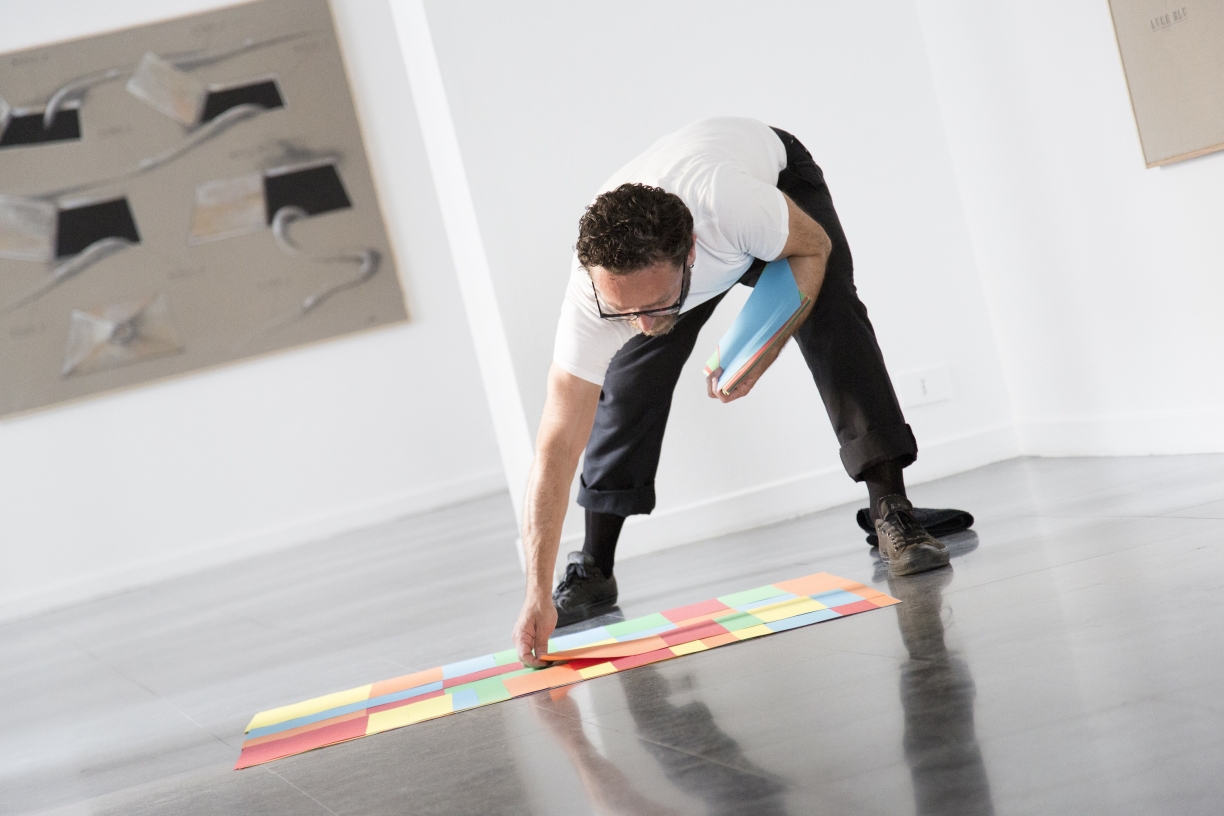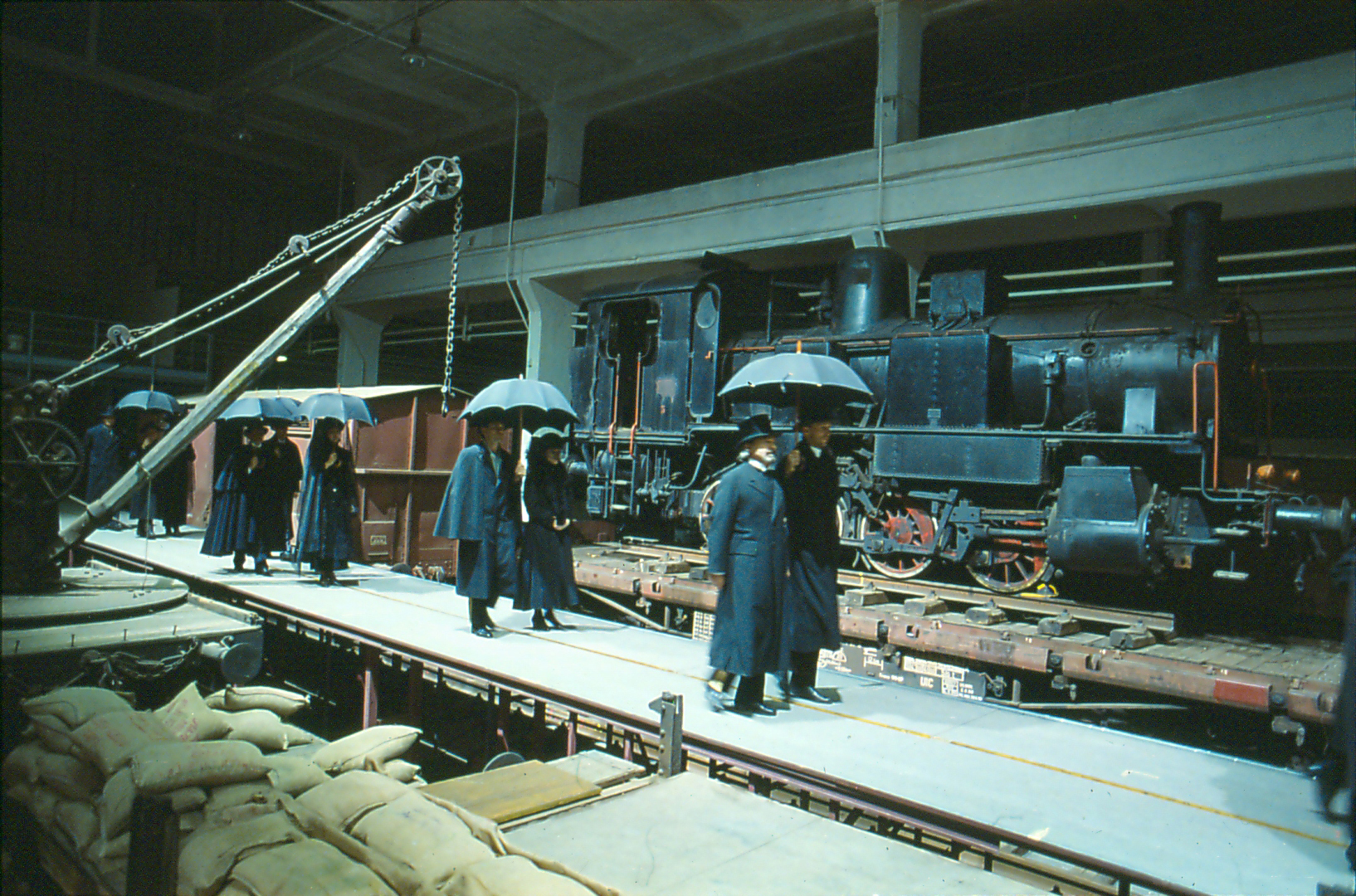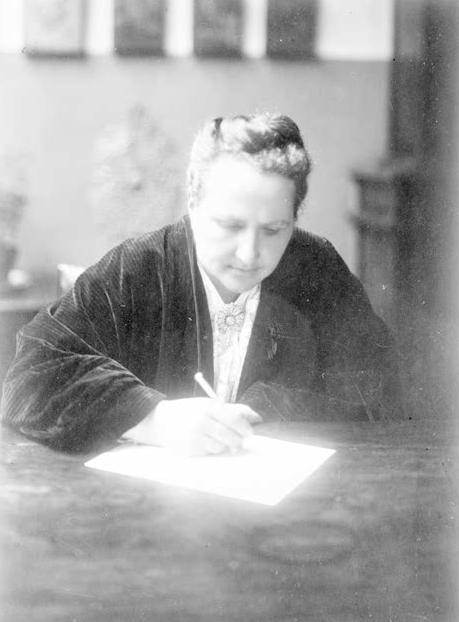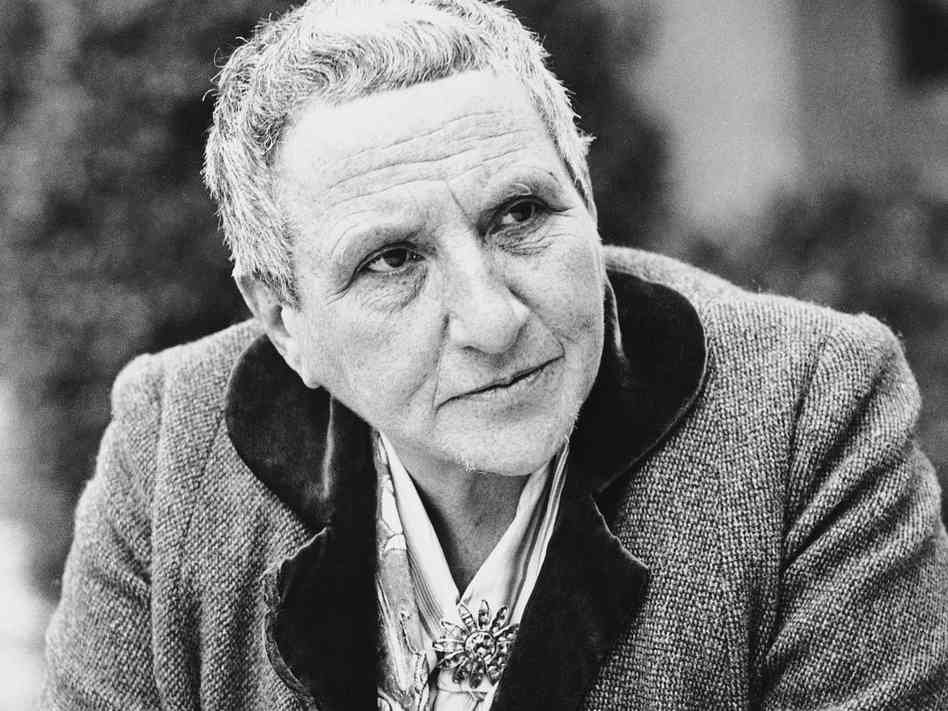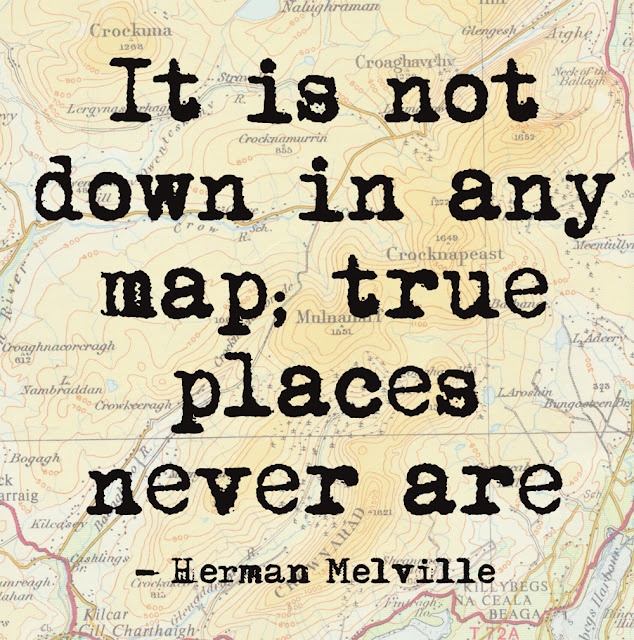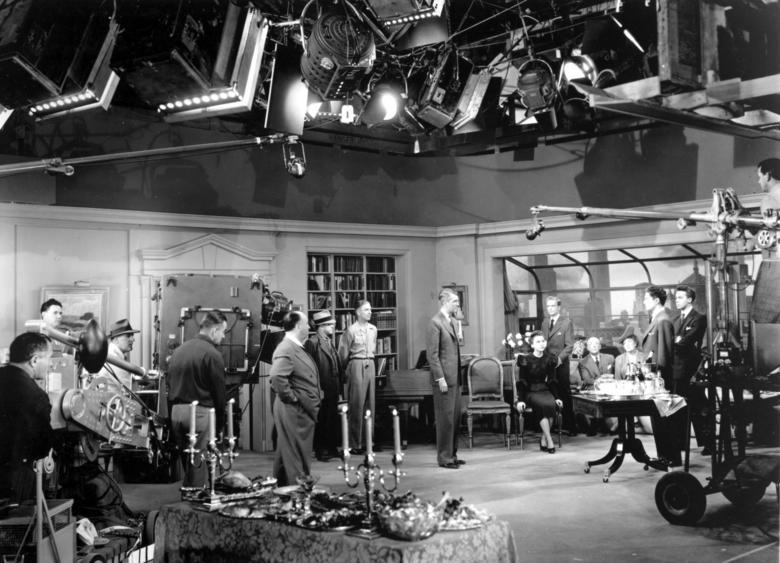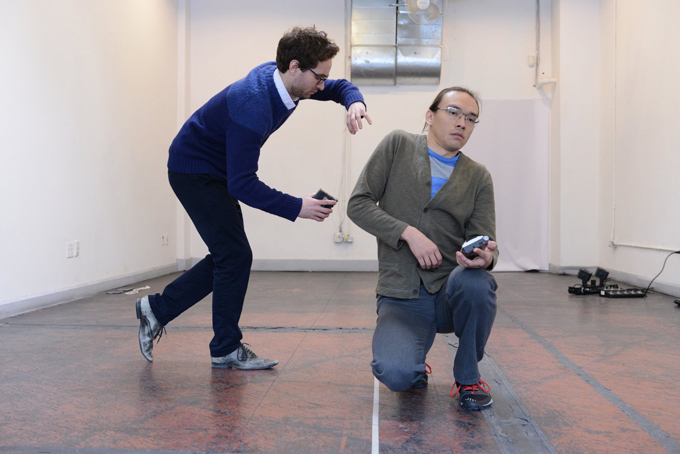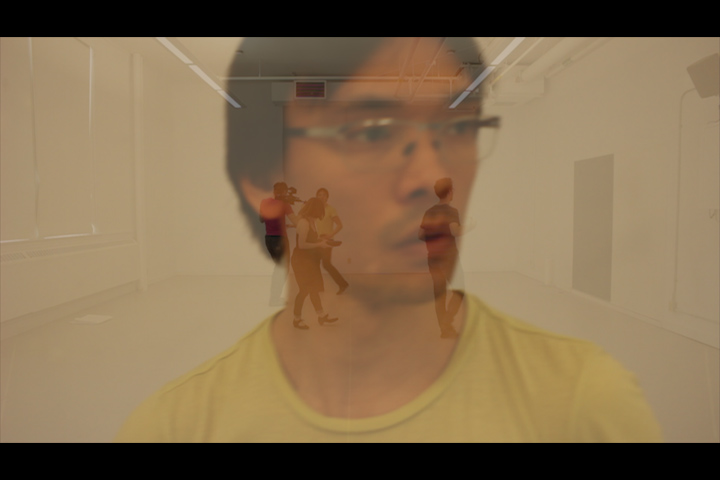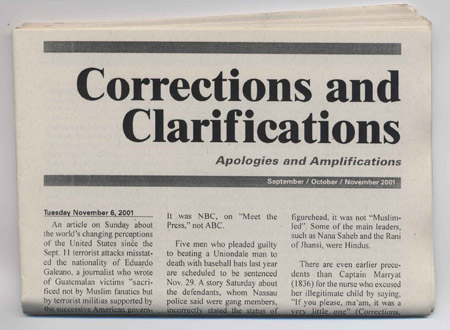A Record of its own Making: an interview with Francesco Gagliardi (January 2017)
Mike: Can you say something about where you grew up, and how you got interested in theatre, and what kind of theatre you did, and perhaps something about your education, how you wound up in philosophy?
Francesco: I grew up in Turin, in northern Italy, and I began going to the theatre with my mother when I was 9 or 10. This was in the early 80s, which was still a pretty good time for theatre in Europe. I got to see the work of some of the great auteurs of European theatre: Strehler, Grüber, Peter Stein. Patrice Chéreau’s Koltès (Dans la solitude des champs de coton), Ariane Mnouchkine’s Oresteia. And of course Luca Ronconi, who later became my mentor and my maestro. But I also got to see the final years of some of the great Italian actors of the older generation, when actors, rather than directors, were the driving force of the production: Paola Borboni, Anna Proclemer, Salvo Randone, Vittorio Gassman… Marvellously over the top. Borboni looked so frail when I saw her — she must have been in her late eighties. It was in a play by Pirandello and she could barely walk. The director had her sit down for most of the play, and when she had to walk she used a pair of hospital crutches. It was incredible. She had been the first actress in Italy to perform in the nude on stage, in 1925.
I suppose that I always thought I was going to end up working in theatre, in one way or another. In Italy acting is taught outside of the university system, conservatory style, but none of the conservatories I knew of really interested me, so I decided to go to university instead. University theatre meant history and theory. I was of course interested in all of that, but it was pretty clear to me that I didn’t want to learn to think about theatre in a regimented, academic way. I had a dangerously charismatic philosophy teacher in high school, so when it came to choose a major I chose Philosophy.
In 1991, one year after I started university, Luca Ronconi, whose work I loved and had been following for years, became the director of the Teatro Stabile in my hometown, and founded a theatre school. The prospect of training with him was incredibly exciting to me, so I switched to a part-time program at university, auditioned for the school, and got in. After finishing the school, which was a rather intense two-year program, I began working as an actor, mostly with Ronconi. I did that for six or seven years. My primary interest, however, was always directing — creating shows. I directed a few small productions, including in 1993 a production of Gertrude Stein’s 1920 play Photograph, but acting was consuming a lot of my time and I didn’t really see a future in it, both because I always thought of it just as a means to an end, a way to get into directing, and because I was beginning to feel that the type of actor I was (my size, my voice) was limiting the kinds of roles I could play. As a colleague of mine once said, “I know I can play angsty teenagers for a few more years, and I know that I’ll eventually be able to play quirky old ladies, but what am I going to do in between?”
There were also other things happening in my life at the time, my mother died, so I thought it was time for a change: I finished my undergraduate degree and moved to the UK to start a Ph.D. in Philosophy. I was very compelled by the rigour of analytic philosophy, by its old fashioned optimism, but probably my choice of pursuing my studies in that tradition had also something to with the fact that analytic philosophy was very much a small niche in Italian academia, which was mostly informed by historicism, and I have always been drawn to the unfashionable. So I ended up studying ethics and political philosophy and thinking about distributive justice. Anyway, to make a long story short, by the time I was nearing the end of my Ph.D. I had come to realize that I did not want to be an academic philosopher: I missed the theatre very much and I missed being involved full time in making art. So I finished my Ph.D. as quickly as I could, and ended up in Canada, following my partner, who had just been hired by the University of Toronto. That was in 2005. My plan was to get involved in the theatre scene, but I soon found out that the kind of theatre I was interested in and had grown up with was simply not around. Instead, I found a very exciting experimental film scene, and I dove into it.
Mike: What’s the first film you made?
Francesco: The first thing I did was finish a super 8 film for which I had been collecting footage for many years. It was based on a 1932 play by Gertrude Stein called Short Sentences. The film is called Short Sentences 1993-2005 (33 minutes, 2005). The play features a list of over 500 characters, each saying a very short sentence.
It is often all sold.
Who will tell what to do.
Which they will tell.
The play’s characters are not an ongoing presence, most of them speak only once. Their names appear before each sentence: Angela Gardner, Evelyn Baker, Emmanuel Dearborn. The play starts in a way that’s similar to many of Stein’s plays at this time, that is, the characters are introduced using only first names: Natalie, Babette, Julia, and the text has the echoed, rhyme-filled quality of a lot of her work:
Will you come.
Oh yes will you come.
But I know you will come.
I ask you to come.
Will you.
I have been able to come.
This is the way she wrote for theatre at the time, using theme and variations. After a number of first names, the name Mildred Aldrich appears, she was an American journalist Stein knew. Here the structure begins to break down; for a while we see Henry who spoke before, and Martha who spoke before, but there’s a transition into something different. After a character called William Rufus speaks, we find only new characters appearing only once, designated by their full names including the surname. The text loses its incantatory singsong and becomes more broken.
Or just the place.
Made by their blessing.
Surely be generous.
Come to be granted.
This is a text she very likely wrote without editing. She sets out to do something, then the thought of her friend Mildred occurs to her and the structure changes. She carries through with that until the end. That’s part of the reason I’m excited about her work, it’s a record of time spent. It’s not a designed composition, it’s a composition that’s being designed, and the work is a record of its own making. Stein wrote plays and opera librettos that were more formally composed and edited, but in many of the shorter plays you see the result of her writing regimen. She would sit down for a certain number of hours and write. What you get is the record of a time spent figuring out an idea, setting out to do something and doing it, sometimes changing her mind along the way and taking off on a tangent.
Mike: Was Short Sentences ever performed?
Francesco: Like most of her theatre, this play was never performed. I started working on this project in 1993 when I was still doing theatre. I had a Braun super 8 camera that my parents gave me for my seventeenth birthday though I’d never used it. I decided to leave aside the first part of the play because I didn’t know how to deal with it in terms of the structure. I started when the play changed to fully named individuals who never appear twice. Each person offers a fragment of an identity: their name.
I gave myself two rules. The first rule was only to approach people that had an identity for me, people that I could tell a story about. I didn’t want to stand on a busy corner and ask strangers to recite these sentences. The film does include a few people I met only once, but in every case it was a striking encounter. For instance, there are a couple of American tourists I met when I was walking with a friend in Rome. They looked fabulous and otherworldly. I think they asked us to take their picture or something. They told us that they had been in Rome for their honeymoon, and now they were back decades later. They were both in their 70s. I asked if they could be in my film and we met at the same spot the next day. They were dressed exactly the same way as the day before: he was wearing a bow tie, she had a floppy sun hat. I think they figured that their appearance was something that appealed to me. I met them only once but there’s still a story attached.
The second rule was to try and explain to each speaker what the project was about. Many of the people I was working with didn’t understand English because the film was mostly shot in Europe. You might have a sentence like: Should may the door, or Who made with it in a likeness. What does this mean? is the first question they would ask. Either you say it means nothing or you can translate it literally (often into Italian) and try to explain. The two rules meant that I couldn’t lie about what I was doing (Oh, it’s an audition for a commercial). So the resulting film is also a trace of hundreds of little conversations about Gertrude Stein.
When I first read the text there were five or six names that right away made me think of people I knew, so I tried to find those people and get them to be in the film. When I couldn’t track them down, I didn’t assign the character to anybody — that’s how this one character called Lillie Fans didn’t make it into the film: when I first read this name I knew it had to be this particular girl from my primary school, but I could never find her. The entire casting is based on the names, not the content of the sentences.
The sentences weren’t shot following the order in which they appear in the text. I would meet someone and think: I want this person to be in my film. Then I would go through the list of names and find a name for that person. There might be three or four names that seemed to work and I would ask: do you want to be Jeremy Waterfield or Todd Anderson? In most cases I would also let them choose the location, preferably outdoors because I was shooting Kodachrome, which needs a lot of light. I wanted them to feel comfortable. If someone was shy about performing in public, I wasn’t going to force them to speak their sentence standing in a busy square. They would choose a name, a location, and then say whatever sentence was attached to the name.
I shot for twelve years and did a little over half the sentences in the original play. As soon as I finished a roll I would send it to Kodak. When they came back I sometime held an impromptu screening for my friends, some of whom were also in the film, and recounted some of the stories about these people and how I had met them. The sound was still on cassette tapes, unedited. I still had no idea about how to edit sound or film.
When I came to Canada I found LIFT (Liaison of Independent Filmmakers of Toronto). Meanwhile Kodachrome had been discontinued. I thought: this is it, I have 12 years of super 8 rolls and audio-cassettes, I need to do something. I took a course in video transferring and telecine. It was so easy, you signed up for a course and showed up with a bag of super 8 and the transfer was done. The audio was transferred by a friend of mine in Italy. I took another course in Media 100 video editing so I could put it together. My film emerged out of those two workshops.
I didn’t shoot following the order of the text, so the order in which the project was shot became a kind of diary. Sometimes shooting occurred while touring a theatre show and all the stops in the tour are in the film. But when I edited, this biographical narrative was disrupted because I put the material back in the order of the text. Actually, because there are several gaps, missing people and sentences, I only used the text as a guideline; I didn’t follow the order exactly. Sometime, for instance, I wanted two people whose characters spoke at different points in the text to appear one after the other, or I wanted to juxtapose two particular locations: two shots with water in the background, for example. Most of the people are holding the tape recorder and turning it on and off themselves. There are many places where you have picture with no sound because they haven’t turned the recorder on yet, or sound without picture. Some people repeat their sentence more than once. A lot of my colleagues in theatre overdo it: one girl has a prop gun; another disappears in a puff of smoke. There’s a guy who appears in profile: he had asked if anyone else had been shot in profile. No one had. He wanted to be unique.
Mike: The variations feel so important, they help make each portrait unique.
Francesco: Absolutely. I never forced anybody. You see the ones who don’t like it… there’s a girl who turns the tape recorder off in mid-sentence and walks away. I couldn’t ask for a second take.
I wrote a series of texts that begin with: Imagine you are… In a way this project feels similar to me.
http://xercises.tumblr.com
Mike: Why are there subtitles?
Francesco: I was interested in the sentences and some are garbled. Some are unrecognizable because of the speaker’s accent. Some people tried to memorize their sentence and scrambled the words.
Mike: The script reappears as subtitles.
Francesco: Right.
Mike: Did I see someone speak more than once?
Francesco: There are a couple of characters in the play who appear more than once; although one I didn’t shoot. The other has a very common name: May Blaine. So it could be the same character or not. I decided to assume it was. The woman who plays that part is someone I was very fond of. She was the mother of a high school friend of mine. She was a sculptor and we had some real conversations about work. Back in high school she was the first person ever to talk to me as if I was an adult and a fellow artist. She brought her son and me to see Lindsay Kemp’s Flowers when we were 16 or 17. The show was rated 18: we were thrilled. I decided to give her this starring role and because it wasn’t a spur of the moment decision, I needed another rule. I decided she would be number 100, 200, 300 in the order of shooting. She appears three times, punctuating the production.
Sometimes I shot a lot and then I wouldn’t shoot for months. It’s strange for me to look at it today because some of the children are adults now, and so many have died. My parents died. Luca Ronconi died. My favourite acting teacher, Marisa Fabbri, offers three versions of her sentence — she was a wonderful eccentric, a marvellous actress. She also died.
Mike: What drew you to the plays of Gertrude Stein?
Francesco: It’s been so long it feels like they’ve always been in my life. It was a fortuitous encounter. Actually, I remember the first time I saw a book of hers: it was at the seaside in the late 80s in a second hand bookstand; it was an old Italian translation of Ida (1941). I had no idea who Stein was. It was a formidable name, and the contrast it made with that short three-letter title intrigued me. GERTRUDESTEIN – ida. The name sat so heavily on that little title. And yet the title had a bounciness that sprung back. I opened it and the first sentence was… well, this is the Italian translation but I’ll try to translate it back.
Once upon a time there was a girl who was born and her name was Ida. Her mom had tried with her own hands to prevent her from being born but when the time came Ida was born. When Ida came her twin sister came with her and so it was Ida Ida.
I thought this is fantastic! There was a library in Turin that had a lot of her original texts but my English was not very good at the time. My first foreign language in school was French. I had a little bit of English but had never read anything. Stein was one of the first things in English that I could read and understand because her language and her syntax were so basic.
I was already interested in theatre and her plays are beautiful to watch on the page. The structures are incredible, and you can actually see them on the page without even having to read it. For example, An Historic Drama In Memory of Winnie Elliot (1930) is a play that contains constant shifts in stage direction. After each new stage direction there is a handful of characters that speak a few lines, then the play moves on. The location keeps shifting ever so slightly.
A room where they had known him.
Inside a room.
Outside of the house.
Inside the house.
A street where they are building.
A building which is not finished.
Partly at the door.
At the door.
Before a building.
A corner building.
In a building.
But of course I was also drawn to Stein’s beautiful language. Its rhythm, the beautiful constructions. The challenge is to take this stuff seriously. The few times it’s performed it is often approached in a very whimsical way, with weird-looking characters saying weird-sounding things. But what happens if you take this seriously? What kind of theatre does it force you to imagine? What kind of actor does it force you to become? What kind of structures does it make possible? Stein has been a constant touchstone.
Mike: What did you do with Short Sentences when it was finished?
Francesco: Not much. It showed at the Images Festival and actually got an award. Davide Oberto showed it at the Turin Film Festival. It was at the CFMDC (Canadian Filmmakers Distribution Centre) for a while, but they did nothing with it. People have picked it up over the years: my friend Dicky Batho, who used to program for the Echo Park Film Centre in Los Angeles, fell in love with it and screened it there, Clint Enns showed it at Videofag in Toronto in a program with work by Phil Hoffman and Andy Paterson, but it didn’t have much of a festival life. I knew so little about festivals at the time. It’s not surprising insofar as it’s 33 minutes long, which is a difficult length to program. It is disappointing, but not surprising. I started to make films because I wanted to make this project. I still very much like it, but it’s hard for me to look at it with a distance.

Phil Hoffman, Andrew J. Patterson, Francesco Gagliardi, Clint Enns after their screening at Videofag
Mike: Is it a structural film?
Francesco: In a way, yes. But it is also funny and sentimental. I don’t think the formalists like it. There’s a certain kind of film crowd that becomes unreflectively suspicious if a film has people in it. Especially if the people are treated with attention and curiosity.
Mike: Do you feel that fringe cinema orthodoxy is a no-person zone?
Francesco: Yes, and I think that’s part of the reason for the difficult reception my work has received. A lot of the people who like it are eccentric in their taste. Perhaps the film appears naïve, although everything about it is very deliberate. When I began to work on it I didn’t know how to shoot. There are out of focus bits, or the speed is wrong because the battery is low. Those mistakes are not deliberate. But the choice of including them in the final edit is. If you saw the footage in order you can see me learning how to use the camera, so hidden in the final film is the record of that process, which mirrors Stein’s recording of her own writing process in the play. I’m not bothered at all by the mistakes; in fact, I keep thinking that I should finish it, but part two would have to be completely different. I couldn’t fake the organic quality that the original has.
I miss the project because for those twelve years I have a record of my life. I believe that the relationships and conversations that underlie the project come through in the film. These are portraits, not just a collection of random extras. There’s an intimacy essential to the project. It is also my way of realizing Stein’s play, which I think is all about the names. Mildred Maine. Edith Archer. Bernard Carter. Janet Stone. Minnie Sherman. They are people. A play with the same lines of text but with the characters designated by numbers – 1, 2, 3, … 521 – would be completely different and I don’t know if I would be attracted to it. It would have to be an entirely different film. I come from theatre, and a tradition where you really engage with texts. This was my way of translating the structure of Stein’s play. What is crucial in my reading of the play is the characters’ names.
Mike: Can you talk more about what constitutes acceptable practice in fringe media? How are canons made, what kind of work is permitted, and what are the characteristics of that work?
Francesco: I don’t know whether I can speak to that. For me, it all happened at once. I moved to Toronto and stopped doing theatre, I decided I wanted to finish this project. I educated myself in experimental cinema reading all I could find. P Adams Sitney’s Visionary Film (1974). Parker Tyler, Scott MacDonald’s interview books, and going to every screening I could see. Everything was new to me. This was around 2005.
What was just beginning was the gentrification of film programming as a profession. The stakes became higher, people started doing it because it had some sort of cultural cache, it was becoming hip – which it definitely wasn’t when I first got here. It used to be just a bunch of people who didn’t spend enough time in the sun and smoked too many cigarettes and were very passionate about what they were doing. People only did it because they wanted to, there was no prestige attached to it. Then things started to change.
In 2009/2010 when I was in New York there was a Kenneth Anger show at PS1, as well as a show of Derek Jarman’s super 8 films at a DIA building in Chelsea that was incredibly interesting in how fucked up it was. His super 8 films were blown up and sprayed across the walls, turned into spectacle. And there was sound in every room, which means that in one room you would see two or three sometimes very different pieces soaked in the same music, always some variation of what I call the dead gay man music: that mix of disco pop and Maria Callas that you hear in so many sanctimonious films about the AIDS crisis: “They were wild but sentimental. They had fun. They are dead. And they kinda brought it upon themselves.” It made me so mad. It was a moment when the art world was sucking experimental cinema like vampires. And the film programmers decided that they wanted in on the prize, they wanted to be as cool as the art curators, but if you want to be cool you become cautious, conservative, less open. You choose work that is already hip in order to capitalize on its existing value.
Mike: Do you feel the art world “added value” to fringe media, introducing hierarchies and lineages, and helped re-imagine it as a curatorial project? A field that could be harvested, ordered, commodified?
Francesco: I think so. Sitney and the others also created canons, but people used to be open to a greater diversity of practice. And of course people’s attention spans have grown shorter, so now the work has to come with its own description, it needs to be recognized immediately. Work has to flag itself, announce what recognized tradition it belongs to. People don’t give it time otherwise. This has been true for a long time in visual arts. I think it’s become true in experimental cinema as well. In the first two minutes you need to figure out what it is and how it fits.
Mike: Where did you turn after Short Sentences?
Francesco: My practice always goes back to performance. I turn to film and video to explore issues that emerge from my live performances. Sometimes my videos are translations of specific live pieces. But I don’t regard this work as performance documentation — rather, it’s a way to rearticulate in a different medium the ideas I explore in performance. When I came to Canada I considered the possibility of working in theatre, but very quickly I became aware that the tradition was completely different here. I wasn’t trained in the psychological, Stanislavskian, feel-what-the-character-feels method. I always laughed at the emoting of American actors. But when I came here I realized that emoting was still going strong. The training that produced these expressions became fascinating to me. I decided to look at it more closely because I was so puzzled by it. I went back to reading Stanislavski, which is the origin of Lee Strasberg’s work and North American method acting.
While reading Stanislavski I became aware of something deliciously perverse at the heart of his project: that the real performance is invisible, it’s only in your mind. If you put yourself in the right state, the appropriate behaviour will emerge. But then, because he’s a man of the nineteenth century, Stanislavski adds that we should of course stylise that behaviour to some extent, make sure that the audience can hear us, make our gestures more graceful, etcetera. But still he claims that the real performance happens inside, and all the training is about feeding certain internal processes. I think this has led to a lot of misunderstanding and self-delusion because so much work actually begins from the outside, from those gestures and that tone of voice, and is then internalized, while the method encourages actors to believe that it is all coming from the inside. Well, if you squint enough while thinking about poor grandma, you will cry. But it’s really the squinting, not the thought of grandma, that does the trick.
So I started working on a series of private performances where I was doing mental tasks as a way to explore the perversity at the heart of the method as literally as possible. Let’s see what happens if I’m really carrying out these tasks without worrying about the way it looks, just focusing on how it “feels” — focusing on what’s happening inside. For instance, I sat down and read the first few pages of Moby Dick (1851) skipping every other word. I made a video of this performance, it’s called “Call. Ishmael” and, aside from the title, it is, unsurprisingly, a rather dull piece.
I have a number of instruction scores for reading pieces. One says: Backwards Book A From Read Silently. It invites you to read silently backwards. Another one says: Silently Silently Read Read Every Every Word Word Twice Twice Keep Keep Track Track Of Of The The Meaning Meaning. Note: note: really really read read each each word word twice twice. Don’t don’t just just repeat repeat it it in in your your head head.
I would perform these scores on my own, sometimes documenting them on video. I also made a few videos of other people performing mental tasks. These are what came after Short Sentences.
In Mental Task 3: Cantor-Bernstein-Schröder Theorem (26 minutes, 2007) Imogen Dickie, who is a philosopher of language, is proving a theorem of set theory on the blackboard. She knows how the proof works, but she is working outside of her area of expertise, and hasn’t rehearsed the proof in a while, so she hesitates and makes mistakes. The film is a single take, and it ends when she manages to work out the entire proof. I didn’t want to film someone who could perform elegantly a well-rehearsed proof, I was looking for the struggle. The original plan was to shoot someone proving Zorn’s Lemma, I thought it would be funny to make a film called Zorn’s Lemma which consisted of a single take of someone actually carrying out the proof, but at the last minute, the logician that had agreed to do it backed out. I suspect that he felt self-conscious about being caught on camera hesitating and making mistakes. He asked me if he could rehearse, I said no. I tried to explain what I was after, but he pulled out.
In Mental Task #4: Relly Raffman: The Secular Masque (20:07, 2007) I worked with Diana Raffmann, who is a philosopher who has done some work in the perception of music, and is also a former professional flute player. Her father was a composer. In the video she’s reading a score by her father. I cannot sight read music, so it’s hard for me to know what is happening in her head, but I imagine that she can hear the music somehow. At some point she starts humming, at another point she seems to mark the beat with her foot. Again, the video is a single take and it ends when she is through with the score.
After a while, I felt the need to break open the solipsism of this practice and I began to look for mental tasks that involved interacting with other people. That’s how I came to the idea of translation as an activity that could be structured as a mental task to be carried out through conversation. I started a series of translation pieces where a native speaker of a language that I don’t speak works with me on the oral translation of a text written in their language — a text that I have a strong connection with. So there’s a struggle. These people are not professional translators, and English is not our first language. I feel I have some authority over the text because I feel a connection with it, I have been thinking about it for a long time but I don’t have access to the original; they have the original, but maybe they have never read the text before, or they don’t care about it as much as I do. There’s a strange tension around that.
The texts I used in this series all relate, in one way or another, to geographical displacement… to being elsewhere. Translation 3: Max Frisch: Tagebuch 1971 (38:10 minutes, 2007) shows Beate Kunath (a German friend of mine, who is also a filmmaker) working with me on an entry from Max Frisch’s diary where the Swiss writer muses on the idea of home and heimat. This work was even less fortunate than Sentences, it was never shown anywhere. I have a single-channel split-screen version that combines this piece with Mental Task #3, the piece with the theorem proof, and it can also be shown as an installation.
Beate: If you’re in a foreign country, and you meet someone from your home country, are you getting homesick or especially not?
Francesco: Or – is that a reason not to get homesick…?
Beate: Yes, reason is the word. In Germany we have a certain name for our home country, it is our home. It doesn’t mean the house you live in.
Translation 6: Shuang Shuang Yan (47 minutes or 13 minutes, 2009) is the translation of a Chinese song from the 1930s. The full version is about 47 minutes but I have a 13-minute version that I submitted to various festivals. It was never shown anywhere. I’m working with three generations of Chinese-Canadians. The song is in Mandarin. Grandpa and grandma speak Cantonese and understand Mandarin. Mom and dad speak Cantonese, and English as a second language. The children are native English speakers but can understand a bit of Cantonese. So there are all these layers of translation. The song loops in the restaurant where we shot, a place they visit often. The cinematographer of this series is the husband of one of the girls, so even though there’s a dolly going round the table everyone is quite comfortable. We listen to the song, some have their own conversations, and we keep trying to understand what the song is saying. At one point I hand out a printed transcript of the text, and we try to work through it.
The song loops through the entire piece. I am hoping to figure out what the text means. More food keeps arriving. The 13-minute version is not edited, it’s just an excerpt showing the moment when the text comes out and everyone starts telling anecdotes related to the song. We watch the performance of translating. This gathering pushes the idea of what it means to carry out a mental task without trying to manifest it. How does it look? Stanislavski meets Chinese buffet.
Mike: You’re sitting at the round table as the camera continually tracks, but you don’t seem eager to direct the proceedings.
Francesco: No, I’m just going along with it. The song is about a pair of sparrows. They love to work. They’re flying high, flying low. They find straw to build their nest. They don’t want anybody’s help. It’s a Mao-era song of love and autarchy. 40 minutes later the song keeps looping.
I was quite surprised that no one was interested in showing this piece. By this point I thought I was being very strategic by making a 13-minute version. I submitted to 40 festivals and no one picked it up.
The next video is more recent. I was still thinking about mental tasks and what the traces of these inner performances could look like. The video is based on a live piece I did in 2013 which emerged out of series of performances I was doing using audio tracks from classic narrative films. I was thinking about movement in the frame. In narrative cinema, the conventions of single-point perspective are so naturalized that we don’t see the flat space, we immediately translate the screen’s two-dimensions into implied three-dimensional space. We do this with such automatism that it is hard to keep track of what’s actually happening in the frame.
The task in these performances is to study a film scene, keeping track of the movement of characters within the frame, and to use the audio of the scene to try and recreate it. The performers use their body to figure it out. They begin by playing the audio off hand-held tape players and they move in and out of, or across, an imaginary frame, trying to synch their movement with the original audio. Every time they feel the movement is not quite right, or if they miss a cue, they can rewind the tape and give it another try, until they are satisfied.
I’ve done several versions of this performance that usually run about 15 minutes. In 2013, Shannon Cochrane produced for FADO Performance Art Centre an hour-long version of this piece that was shown at the Images Festival – it was based on Hitchcock’s Rope (1948) and it was called Film:Rope. Instead of a single scene there were multiple scenes, each with a fixed duration. It featured four performers: Cara Spooner, Michael Caldwell, Marcin Kedzior and myself.
Mike: How did you choose which scenes you would work on?
Francesco: I was thinking mostly of the spatial and aural feel that might emerge from each segment, ignoring dramatic considerations. In other words, I did not pick scenes that were significant in terms of the dramatic development of the film, but scenes that I anticipated would result in a certain kind of movement.
I was also thinking about sound, choosing scenes that contain very specific “accents” or “marks” (a doorbell, a car horn, gunshots, a distinctive pitch in the articulation of a line of dialogue), and in how those accents would recur and combine in the performance, creating effects of repetition, phasing, overlap, echo, hiccup, etc. The performance has a very strong sound component.
In terms of movement, I composed the selection considering the juxtaposition of busy scenes with more static ones, and scenes involving wide, cross-stage movement with scenes encouraging a focus on small actions and gestures (playing with a rope, drinking, lighting a cigarette, shooting a gun). I was considering how these more recognizable actions would punctuate an overall texture of less specific, less recognizable movement.
I was interested in how the actor’s movements on set, and the movements of the camera, translate into different kinds of movement within the frame – and how these would translate differently in performance. For instance, there can be a scene where the characters are static and the camera zooms in on them. And there can be another scene where the camera is static and characters walk towards it. In both cases, the characters’ position and size within the frame would change in a similar way, but the two sequences would look very different in the performance. In choosing scenes from the film, I was looking for specific qualities of movement along these lines. For example, at one point in the performance I juxtaposed two different kinds of movement along the downstage-upstage axis. In the first scene, Ms. Wilson and Rupert stand by the trunk while the camera zooms in and out, suggesting Phillip’s line of gaze; in the second scene, the camera remains on Rupert who stands still by the trunk, while Ms. Wilson walks back and forth from the kitchen tidying up after the party. In both cases Cara (who tracked Ms. Wilson in the performance) ended up walking along the upstage-downstage axis, but her two walks translated entirely different things, and had a very different quality.
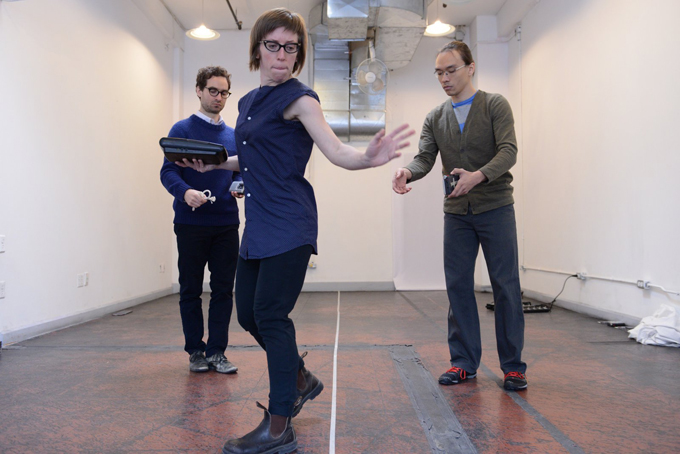
Marcin Kedzior, Cara Spooner and Michael Caldwell in Film:Rope by Francesco Gagliardi. Photo by Henry Chan.
Another important compositional principle was the juxtaposition of scenes that had been studied and rehearsed to different degrees of detail and precision. In the course of performing previous versions of this piece, I noticed that the more a performer becomes familiar with the scene, the choppier the performance becomes: the performer will remember more details, and as she tries to match them exactly to the audio, she will have to stop and rewind more frequently. If a scene has been rehearsed only a few times, on the other hand, the performer will tend to go through longer sections of audio without a lot of interruptions. By varying the amount of rehearsal time put into each scene, it’s possible to make the scenes more or less fragmented and create texture in the performance.
The sound works as a script or score, but it is also a tool. The performers start the tape players at the same time. However, each performer makes mistakes forcing them to stop and rewind at different times. So the sound starts in unison, but since each performer is following their own tape player, the sound goes in and out of sync.
I was very happy with this piece and I wanted to have some good documentation of it. But I hate those slick videos that make the performance look like something that it was not. So I tried to think of the video version not as documentation, but as a translation — a new version of the performance. I picked out one scene from the Film:Rope performance that featured three characters and then added a moving cinematographer. Instead of tracking a character, the cinematographer (Robert Kingsbury) is following the original camera design, using a tape recorder like the other performers. So he listens to the audio and knows he has to pan-pan-pan-pan then land on the murder weapon. If he gets there too quickly he rewinds and starts again. There are no props in the room, and he’s not trying to follow the other performers. Like them, he’s also trying to remember the original scene. He’s continually resetting in order to perform his memory of the camera movement.
There’s a stationary camera shooting the entire scene in master shot on a tripod. The moving camera POV is superimposed with the stationary camera. The transparency ratio between the two shots keeps changing. This effects how much you see of one shot or the other. When the cameraman is performing his recollection of a camera movement, his POV is dominant; when he’s resetting and rewinding the tape, the master shot is dominant. The opacity keeps changing. The difference is small at the beginning, and grows until it ends with an actual cut. The last time he is resetting, you just see the master shot. The last time he’s shooting, you just see his POV.
The proscenium arch is the imaginary frame. Ideally, to indicate the camera closing up on a shoulder, the performer’s shoulder would become as big as the entire room. In fact, the performer would just move closer to the audience and maybe do something with his shoulder. In theory this performance could happen with all of them sitting down and just trying to remember, but it’s easier to use the body. They are not re-enacting the scene, they are using their bodies to mark memories. Their task is to remember the relationship of actor and frame, and they use their body to do that. They are essentially marking.
Mike: Why is the camera person moving so much?
Francesco: The camera person is doing essentially the same task as the other performers. He’s marking the original camera movement from memory. If he remembers a pan going along with a certain line of dialogue, when that line comes up on his tape he marks that pan, perhaps using an exaggerated movement.
I’ve done this piece with other movies but only in performance, always using narrative films. On August 8, 2009 I performed a piece based on Hitchcock’s The Birds (1963) at Barnard College in New York City, with Jennifer Walshe and Kara Feely. It was a scene with lots of shot-reverse shots, and lots of birds chirping in the soundtrack. I liked the hectic quality of the movement and sound.
There is a group in Tokyo called Ensemble for Experimental Music and Theater. I don’t know them. But they did a very quiet version of Ozu’s Tokyo Story (1953) based on my score. The few times the piece has been performed by people other than me, it has been in experimental music contexts. I love their version because they’re basically just standing up and sitting down. And the sound is so very sparse.
Let me show you something that isn’t finished yet. The starting point is a score that I’ve been obsessed with for many years. It’s by my friend Doug Barrett. He was finishing a PhD in music in Buffalo while I was doing my MFA there. He wrote this piece called Two Voices (2008) that I love very much. This is what the score looks like: it’s a number of straight lines. Each pair of lines shows a way in which two performers can coordinate an action. Here the lines are the same length and right on top of one another: the actions start and finish at the same time. Here the bottom line starts right below the top line, but it is shorter: the two performers start their action together, but then whoever is performing the bottom line ends his action first, etc. There are nine possible variations. The score is in three parts: each part contains a series of the same nine variations, presented in a different order. I love the wild potential of this. The score indicates that the lines can stand pretty much for anything: a tone, a sound, an action, a noise. The people who had done it before me were musicians; they realized the score playing tones on musical instruments. The result can be very beautiful: two tones starting together as a discord, sustaining for a while, until one stops letting the other continue for a short time as a solo. Sometime there would be sudden, unexpected accords. I really loved this piece. So I started doing it using actions.
The first time I performed it was with Doug, the composer. We used the action of sitting down. We would sit down together, then stand up together. Then another variation: we would sit down together, Doug would stand up while I remained seated, then I would stand up, etc. After that, I started doing sound realizations of on my own. In one instance I used two radios. In another version I used pitchers of water and glasses — pouring water into the glasses. I also did a realization in which I used a blank board: the action was pushing it forward; top and bottom lines indicated right and left. I would push forward the right side, then the left, then I sopped. Then I would bring the board close to my chest again and another variation would begin: I would push both sides forward, then one side would stop, while the other side would continue its forward motion in a slight diagonal, etc.— each variation traced a different volume in space.
This is already narrative. Imagine an action where two people arrive together, then one leaves, and then the other one leaves. Or one arrives first, then the other one arrives, and they leave together. There’s a whole drama there. What if I enter a room with an attractive man, or a very old woman? And one of us leaves first? What if you arrive first, then I arrive, and as soon as I arrive you leave? This is narrative.
I asked Clint Enns to shoot the piece on VHS and went through the score with three pairs of people, one pair for each series of nine variations. They would walk in, sit on a couch, and leave — in all possible combinations. The first pair was Tess Takahashi and Leslie Supnet. The audio is just my voice directing them. “On my count of three please walk in together. One, two, three.” (Tess and Leslie sit on couch). “Les you go out. Tess you go out.” This is the first iteration of nine. Then I made a second set with Les and Will Ellis. The third set is a slightly wider shot with Tess and Amber Christensen. There’s a weird tension in each of these scenes.
I still haven’t decided what to do with this footage or how to treat the sound. I wrote a lot of text for this piece, scenes of people bickering; I even recorded the texts with Shannon Cochrane and Scott Miller Berry. We read in different pairings, with a lot of gusto. We had a lot of fun. I was happy with the texts and the recordings, but as soon as I put them together with the images they didn’t work at all. I have some fondness for the dry directions that I give, but I think I need something else as well.
Other than that, I am still shooting the odd super 8 film. I have a few now. Clint is always after me to show them, but I don’t consider those as work. I’m just having fun.
Mike: What about your most recent performance work?
Francesco: I just did a piece at the 7a11d festival in Toronto, and about a year ago I performed in a program at Issue Project Room in New York (October 27, 2015). The set I performed there consisted of a series of short pieces in which I manipulate objects over a tabletop. One of the pieces in the set was called Five Rooms.
It’s a very carefully rehearsed piece, which I developed through improvisation with a number of black and grey cardboard sheets. I’m working with specific memories of the apartment where my parents lived before I moved away, the apartment where both of them died. The piece is a series of spatial memories: the way a room caught the incident light, a door that was always open… I move the boards, translating these memories of space and light into deliberate manipulations. But I’m not trying to convey the specific content of the memories. What interests me is how this very personal material can be translated into a formal sequence.
Here is another space. It’s a villa in Varese, near Milan, which hosts a small private collection of contemporary art that I’m rather fond of. I’m working with memories of a room designed by James Turrell. Turrell was an American artist born in 1943, part of the Space and Light Movement. Once again I’m trying to go through the memory of a space, and how the room appeared to me. This embodied spatial memory is again translated into a sequence of manipulations. I use two boards and a stone, I flip the boards up so that the stone is hidden behind them, then one board comes down and reveals the stone against the background of the other board. I change the spatial relations between these objects, playing with what is seen and what is not seen. Concealing and revealing. I’m creating three-dimensional space and then returning to flat space. There’s a bit of fake magic at work here.
Another piece is in response to The Kimbell Art Museum, which is in Fort Worth, Texas, and was designed by Louis Khan. I love this building. The architecture is in three big sections. The piece, which is very short, is built around sequences of three movements. I use a blank sketchbook with a thick black hardback cover; I flip it around, I open it and close it — towards the audience, towards me, holding it up, or flat on the table. This was originally part of a series of pieces made in response to buildings that host art institutions: galleries, museum, private collections. It started as a series of three, then five, then it ended with seven. I called it Seven Museums (2009-2011). I haven’t performed the whole piece in a while, but I still repurpose sequences from it. This is one of them.
Mike: Do you feel that your formalist concerns also carry a political weight? How do your movies and performances respond to the neo-Liberal consensus that has swept our city (of Toronto)?
Francesco: I don’t know what it means for work to carry political weight. I see lots of work with a political content. But then politics is just a subject matter like any other. Some people treat it well, some people treat it in ways that are not very interesting. My friend Anita Di Bianco has a wonderful project called Corrections and Clarifications, where she collects selections from major newspapers’ “corrections and clarifications” sections as a way to reveal what lies behind the lapses, slips and blunders of public discourse. She began this project in the aftermath of September 11 and has been continuing it ever since. I love this project, but this is not my territory; I don’t have anything to say about politics.
http://www.anitadi.net/cc.php
Then there is work that has, or tries to have, a real political impact. Pontecorvo’s The Battle of Algiers (1966) is a political work in this sense, but it was a major feature film. I don’t think anyone in the small niche of experimental art can claim to do that: our audiences are just too small and too homogenous for the work we share amongst ourselves to carry that kind of weight. And finally, there are the politics involved in the making of one’s work. How do you sustain your practice, what kinds of distribution strategies do you implement, what compromises are you willing to make? I think about this all the time, and I have very strong ideas about it. For one, I refuse to give in to a neo-liberal model of cultural production that requires artists to be constantly producing new work, have a new film for every festival submission deadline, always be where you should be seen… Some people naturally work like that: they make a lot of work, they are constantly talking to everyone. And of course that’s totally fine if that’s their process. But it’s not my process. It takes me a long time to make something. I backtrack, I change my mind, I throw away, I hide. And I’m not going to change my way of working just so that I can keep up with the expectations of a cultural market I have no interest in. That’s just the way it is: I don’t know whether I could go about it any differently even if I wanted to. But it’s also a very self-conscious political stance, albeit a very modest one.
Mike: What is the place of emotions in your work? Grief, tragedy, heartbreak… Your work is so heady, so formally precise, what advice would you have for viewers looking for a few more emoting roadsigns?
Francesco: The work is entirely fuelled by emotion. The impulse behind it is always affective. The performance work I have described to you is fed by thoughts of death, mourning, beauty, loss… it is haunted by memory. I may not be trying to communicate any of this, but this is the material I am using. It may not be what the work is about, but it’s what it is made of. My way of dealing with it is turning it into form: I often start with a very specific memory, I translate it into a sequence of actions, rehearse it over and over, until it feels like it has turned into something else, something that doesn’t need me in order to exist. Form is a strategy of displacement and release, a way of managing excess. Excess of memory, excess of desire… The texts I use in the translation series are about geographical displacement, about longing for an elsewhere. And the process of translation itself is an attempt to work through the lived experience of being immersed in a language that is not your own. This is my life! I’m not going to tell you about it: the confessional mode is utterly foreign to me. But there is nothing I do which is not deeply personal.
There is a moment in the history of western thought that has always moved me: it is that historical juncture at the end of the Eighteenth Century when the project of Enlightenment (the encyclopaedic ambition to understand, explain, contain, systematise) begins to break down and Romanticism appears, revealing the Other (other people, Nature, History) as a fundamentally intractable mystery. I am deeply moved by the obstinate attempt to hold on to that project in the face of this excess, this intractable overflow. You know you cannot contain it, but you keep behaving as if you could. You see this in early Romantic German literature: the theater of Lenz, Kleist’s plays and short stories, Goethe’s Elective Affinities (1809). Even as far back as the late Lessing: The Education of Humankind (1780) is still full of the optimism of Enlightenment, but it’s pervaded by an elegiac tone that already betrays a sense of loss: “This is what we believed in”. It’s a manifesto, but a manifesto about the past: a contradiction in terms. I find that incredibly moving. All the work I love manifests this tension: a formal surface that tries to manage, but never entirely contains, an excess of… something else. You may or may not grasp what it is, but you see the form fighting to shape it, organise it. This struggle is what I love. You see it in the work of Agnes Martin, in the shape of Proust’s endless sentences. And it’s there in Gertrude Stein. I have no interest in the free play of form. Only in form that fights and fails. And keeps fighting.
